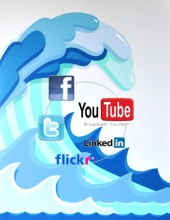In the old days there was only one kind of audience…the ones that media created. TV shows had ratings, magazines and newspapers had subscribers and radio shows had listeners. Advertisers hopped on board by buying advertising on these shows and print vehicles. Of course, these audiences are still significant but now there is a new type of audience in a digital and social age…one accumulated by the brand itself.
In a digital and social age, brands are media with their own audiences.
Brand Coca-Cola has an audience on Facebook (53 million fans) that is nearly triple the size of the top rated TV show. In fact, Socialbakers.com shows that 47 brands have Facebook fan bases that are above 10 million! Consider and compare the direct competitors, Starbucks and Dunkin Donuts. Starbucks has 25 million more fans on Facebook than Dunkin Donuts which means that 4 times as many people on Facebook will see every Starbucks update vs. every Dunkin Donuts update. So there is a straight arithmetic reward in terms of social media impressions as you build your audience/fan base.
And the size of the brand audience can extend well beyond Facebook as now someone can follow your brand on Twitter, Google+, Pinterest, subscribe to a Youtube channel that is brand-sponsored, and they can download your branded app into their smartphone and tablet. Consumers can also sign up for e-mails and regularly visit your website.
Do brand audiences have an impact?
Absolutely! From my work using Compete data, I proved that people who become fans of a brand on Facebook have an average increase of 85% in visits to owned media websites for that same brand. Earned impressions are starting to be shown to have an impact on sales via marketing mix modeling (proven by my own work and also work from others I have seen presented).
Also note the synergy; social media doesn’t replace TV advertising it amplifies it! It has been shown that TV advertising drives search, Facebook fans and conversation throughout social media like Twitter which ultimately all amplify TV advertising effectiveness.
Brand audiences for media companies (thinking of them as brands themselves) are important as well. Advertisers are increasingly requiring a certain number of updates and tweets to seal big media deals. So for example, the attractiveness of advertising on a show like The Voice is now partially predicated on their Facebook fan base over and above their actual TV ratings!
Another huge benefit of brand audiences in social media that marketers are just awakening to is the insights value. When you have a big brand audience, you can analyze their interests and just as importantly, the overlap of those liking your brand with media properties they are also like, leading to improved ad targeting. A company called “General Sentiment” has made great progress in this area.
Are marketers appealing to their new audiences correctly?
Not really. Let’s start with a basic fact. The percent of fans who actually visit a Facebook page in a given month for a brand they have liked is usually well below 1%. Obviously, a brand should want this monthly visitation rate to be something of much more significance…maybe 25% or even 50%. So why is the visitation rate so low? I’d guess there are three reasons: low entertainment value; not enough valuable offers; and updates in the newsfeed that are not designed to encourage fans to go back to the page. On the point about entertainment value, brands have moved into the entertainment business but have not done a good job of recognizing and executing against this idea IMHO.
Measurement practices must catch up to “brand as media”
Research and insights departments can help to drive this transformation in thinking but measurement concepts are still lagging behind. I recently saw an Adobe/Omniture webinar entitled “Fans are not a business metric”. Actually that is totally false in the era of brand audiences. In fact, I advise my clients that they should create a KPI for “brand audience” that summates audiences across social and owned media. A marketer should want that number to go up, up, up over time and out-perform competitors. Other metrics I advise my clients to create relate to a clearly specified way of tracking paid, owned, and earned media. Especially, with earned media, there is huge variability in practice and I tell my clients they need to own the calculation so it is repeatable and therefore a basis for learning.
“Brand as media” is a sea change but marketers are still trying to figure this out. You no longer compete just on features and functional benefits. Brands are now competing for lifestyle, entertainment, and a sense of belonging to build their audiences. If you do it right you get a brand like Starbucks with its 33 million Facebook fans.


so interesting, joel — as brands become media, media are becoming brands (e.g., espn) — both types of business need to think differently about how they create and communicate value — denise lee yohn
Hi Denise:
It gratifies me to hear I can stimulate the thinking of someone who is best in class, such as yourself.
HOpe all is well…
Joel
Thanks for the great blog on “Marketers need to start thinking of their brands as media”. I own a Seattle Washington Market Research company. I’m sure my employees and I will learn alot from what you’ve posted here. Keep up the good work.visit us @ http://www.outsourcingpros.com/Seattle-washington-market-research/42